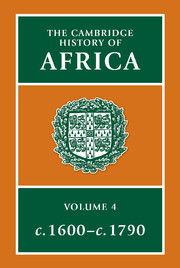Book contents
- Frontmatter
- Introduction
- 1 Egypt, the Funj and Darfur
- 2 The central Sahara and Sudan
- 3 North-West Africa: from the Maghrib to the fringes of the forest
- 4 The Guinea coast
- 5 Central Africa from Cameroun to the Zambezi
- 6 Southern Africa and Madagascar
- 7 Eastern Africa
- 8 Ethiopia and the Horn of Africa
- 9 Africa in Europe and the Americas
- Bibliographical Essays
- Bibliography
- Index
- References
8 - Ethiopia and the Horn of Africa
Published online by Cambridge University Press: 28 March 2008
- Frontmatter
- Introduction
- 1 Egypt, the Funj and Darfur
- 2 The central Sahara and Sudan
- 3 North-West Africa: from the Maghrib to the fringes of the forest
- 4 The Guinea coast
- 5 Central Africa from Cameroun to the Zambezi
- 6 Southern Africa and Madagascar
- 7 Eastern Africa
- 8 Ethiopia and the Horn of Africa
- 9 Africa in Europe and the Americas
- Bibliographical Essays
- Bibliography
- Index
- References
Summary
Historians of North-East Africa have been largely concerned with developments in the kingdom of Ethiopia and, to a lesser degree, with the principalities of the coast. These communities were literate, had recorded their history and were occasionally visited by foreigners. The Galla peoples on the other hand, illiterate until modern times and considered hostile to foreign visitors, have been relatively neglected, but the story of their great migrations, the evolution of their society and culture, the growth of their political power and their transformation into the predominant element in the Horn of Africa is in reality the principal theme throughout this period. Even contemporaries in Ethiopia failed to recognize for a time the significance of the Galla invasion, for they remained largely preoccupied with internal rivalries and with the threat still posed to the Christian kingdom in the second half of the sixteenth century by the Muslim elements of the coast.
THE MUSLIM THREAT AND THE GALLA EXPANSION
Imām Ahmad Gragn, who had conquered Ethiopia at the head of the armies of Adal and dominated the country for more than a decade, was killed in 1543 at the battle of Woina-Dega. Galawdewos, who had succeeded his father Lebna-Dengel in 1540 as king of kings of Ethiopia, quickly reconquered the northern and central plateaux, but it took him several years to overcome the resistance of the rulers of Damot and the Muslim sultanates of the south. By the beginning of the 1550s, Ethiopia was once again united within its old borders. Nevertheless, Galawdewos realized that most of the factors which had contributed to the collapse of the kingdom in the days of his father were still in existence.
- Type
- Chapter
- Information
- The Cambridge History of Africa , pp. 537 - 577Publisher: Cambridge University PressPrint publication year: 1975
References
- 2
- Cited by



